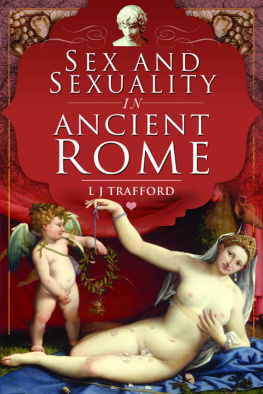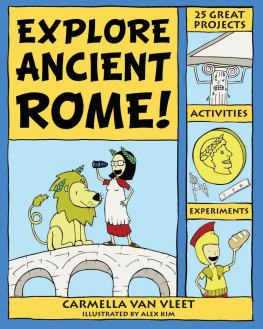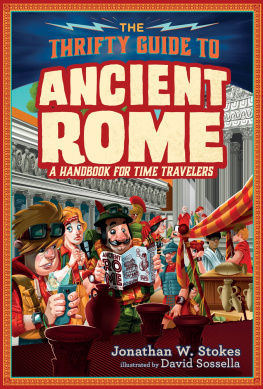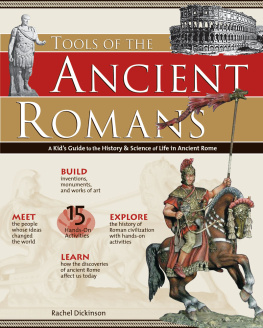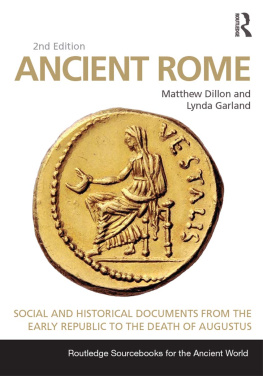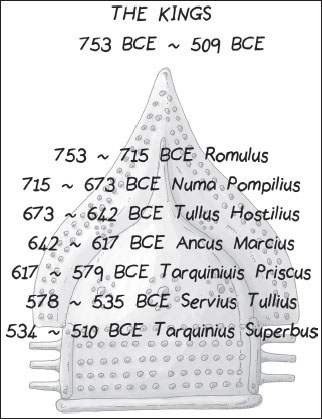
HOW TO SURVIVE IN
ANCIENT
ROME
For Samuel and Patrick, as proof that Romans arent boring.
HOW TO SURVIVE IN ANCIENT ROME
L J TRAFFORD
First published in Great Britain in 2020 by
PEN AND SWORD HISTORY
An imprint of
Pen & Sword Books Ltd
Yorkshire Philadelphia
Copyright L J Trafford, 2020
ISBN 978 1 52675 786 9
eISBN 978 1 52675 787 6
Mobi ISBN 978 1 52675 788 3
The right of L J Trafford to be identified as Author of
this work has been asserted by her in accordance with the Copyright,
Designs and Patents Act 1988.
A CIP catalogue record for this book is available from the British Library.
All rights reserved. No part of this book may be reproduced or transmitted in any form or by any means, electronic or mechanical including photocopying, recording or by any information storage and retrieval system, without permission from the Publisher in writing.
Pen & Sword Books Limited incorporates the imprints of Atlas, Archaeology, Aviation, Discovery, Family History, Fiction, History, Maritime, Military, Military Classics, Politics, Select, Transport, True Crime, Air World, Frontline Publishing, Leo Cooper, Remember When, Seaforth Publishing, The Praetorian Press, Wharncliffe Local History, Wharncliffe Transport, Wharncliffe True Crime and White Owl.
For a complete list of Pen & Sword titles please contact
PEN & SWORD BOOKS LIMITED
47 Church Street, Barnsley, South Yorkshire, S70 2AS, England
E-mail:
Website: www.pen-and-sword.co.uk
Or
PEN AND SWORD BOOKS
1950 Lawrence Rd, Havertown, PA 19083, USA
E-mail:
Website: www.penandswordbooks.com
List of Illustrations
Timeline of the Kings by Simon Walpole.
Timeline of the Republic by Simon Walpole.
Timeline of the Empire by Simon Walpole.
Map of Rome in 95 CE.
Pyramid showing the social classes in Rome.
Photograph of the Senate House. (Courtesy of Scott Rowland)
Augustus Caesar. (Photographic postcard, 190 (Wellcome Collection CC BY)
Two lictors. (Morphant Creation/Shutterstock)
A man wearing a toga. (Morphant Creation/Shutterstock)
Female Roman dress. (Vintage illustration from Die Frau als hausarztin 1911/Shutterstock)
Flavia Julia Titi, daughter of Titus. (Vintage engraved illustration, Shutterstock)
Atrium of the house of Sallust. (Vintage engraved illustration. Private life of Ancient-Antique family-1881/Shutterstock)
Ancient Roman interior frescoes in Pompeii. (Shutterstock)
Garden in Domitians palace on the Palatine Hill. (Courtesy of Scott Rowland)
Flamingos.
Ancient Pompeii. Thermopolium of Asellina with old food serving counter. (Shutterstock)
The Colosseum. (Courtesy of Scott Rowland)
Gladiator mosaic. Fragment of ancient mosaics, Kourion, Cyprus. (Shutterstock)
Plaster mask with hollow eyes and mouth. (Wellcome Collection CC BY)
Domitians palace on the Palatine. (Courtesy of Scott Rowland)
Roman infantry drawing. Centurion and signifier. (Shutterstock)
Reconstruction of Roman weaponry. (Rolf Krahl, CC BY-SA 2.0 https://creativecommons.org/licenses/by-sa/2.0 )
Ivory statue of Apollo, Roman, 200 BCE-300 CE. (Science Museum, London. CC BY)
Terracotta votive scalp, Roman, 200 BCE-200 CE. (Science Museum, London. CC BY)
Cornelia, the Vestal Virgin, entombed alive surrounded by bones in the dungeon. (Line engraving by G. Mochetti after B. Pinelli. Wellcome Collection. CC BY)
Ancient Roman silver denarius coin of Emperor. (Domitian/ Shutterstock)
Detail of Cicero marble statue in front of Rome Old Palace of Justice. (Shutterstock)
Graeco-Roman bronze phallic pendant. (Wellcome Collection. CC BY)
Graeco-Roman surgical instruments. (Wellcome Collection. CC BY)
Ajax and Hortensia images both by Carol Klio Burrell.
Welcome to Ancient Rome
So, you think you know ancient Rome? After all, youve seen Gladiator six times, you can use Et tu Brute wittily in conversation and you can pepper political debate with tales of crazy Caligula making his horse a senator.
Except that you dont. Caesar never said Et tu Brute, Caligula never made his horse a senator, and Commodus definitely didnt meet his end at the hands of a hunky gladiator with an attractively growly voice. Commodus was murdered by a wrestler named Narcissus, whod been set the task by the empress, after the emperor had vomited up the poisoned beef shed served him. Proof that fact is indeed stranger than fiction.
Ancient Rome is a pretty strange place: clothes are washed in wee, babies are left in the rubbish and bad luck can be averted by wearing penis jewellery. But dont panic. We are here to guide you through this strange new world. We shall provide you with practical advice that will prevent you from accidentally insulting the locals, committing social faux pas of an embarrassing nature and help you avoid being sewn up in a sack with a snake, a dog and a rooster.

Along the way you will meet our two experts: Titus Flavius Ajax and Hortensia. Titus Flavius Ajax is a former imperial slave and now secretary to his Imperial Majesty, the emperor. He will be providing all the information you need to know on all matters imperial and all the top gossip from the palace. Hortensia is a lady of (mostly) leisure. As a member of Romes elite class Hortensia has everything youve always wanted to know about the ultra-rich but were too afraid to ask. She also has the inside line on what its like to be female in the Roman Empire.
Romans are enormously proud of being Roman. As Pliny the Elder says: Undoubtedly the one race of outstanding virtue in the whole world is the Roman. wine, nibble on a roasted dormouse, and relax as we take you on a tour of 800 years of history.
The History of Rome: The Basics
Romes story can be roughly broken down into three parts: the Kings, the Republic and the Empire.
Before the Kings
Before there were kings of Rome and before there was Rome even, there was Aeneas. Aeneas was a hero of the Trojan War (yes, the one with the wooden horse) who, fleeing the destruction of his home city, underwent many adventures and trials, eventually ending up in Italy.
Aeneas settled himself within spitting distance of where Rome would stand, somehow never spotting that it was the perfect location for founding a city. Instead he went about founding a dynasty of kings, none of whom mustered the energy to build Rome.
The Kings
Dates 753 BCE509 BCE (approximately).
The first king of Rome was Romulus. The story of how he came to found the city is familiar to every man, woman, child and slave in Rome. To fit in successfully you too will need some familiarity with this tale, if only to avoid embarrassing yourself asking: Hey, whats with all those statues of those babies suckling from that dog?
The descendants of Aeneas had been ruling a part of Italy that was very close to the site of Rome but did not include Rome as the kings of Alba. In the eighth century BCE King Amulius set about securing his throne by killing all of his male relatives. This was exhausting work and to save himself the effort of having to kill any more, he forced his niece, Rhea Silvia, to become a Vestal Virgin. do by impregnating Rhea Silvia with twin boys.
Next page



